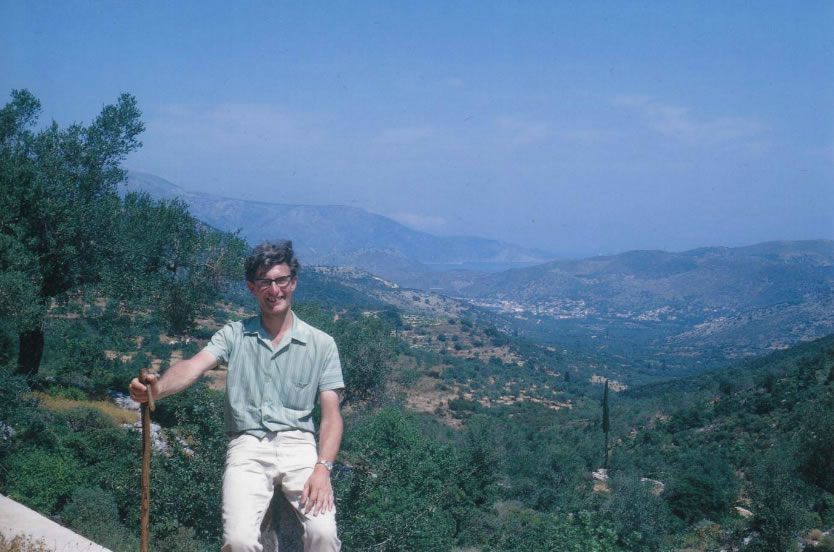Walking guide to 42 Greek islands (1987)
© Gerald Ephraim Nektarios Thompson, Mesagros, Aegina, Greece, 2014.
Transcription by David Royle, Scarborough, North Yorkshire, England.
First Edition: 15 March 2014.
CLICK HERE to read the walking guide online
CLICK HERE to download the PDF
Gerald Thompson was born in 1933 in the Northern English industrial town of Wakefield, West Yorkshire. His family was working class Methodist, closely involved in church music and song, and music has played a central role throughout Gerald’s life. Wakefield is a short drive away from the Pennine Hills and the Yorkshire Dales, fine open, hilly countryside which helped to inspire his love of walking. A turning point in Gerald’s life was winning a scholarship to Queen Elizabeth’s Grammar School, Wakefield, where he was introduced to Classics, becoming so enthused by Greek in particular, that he won a Hastings Scholarship to study Classics at The Queen’s College, Oxford.
Gerald taught Classics at Hymers College, Hull from 1957 to 1985, inspiring several generations of students, not least through his legendary Easter school trips to Greece, and achieving outstanding success in University entrance exams, especially to Oxford and Cambridge. When, in 1985, Hymers College removed Greek from the curriculum, Gerald took early retirement and taught Greek at Hull
University for several years before moving permanently to Greece, working part-time as a tour guide.
Since 1990 Gerald has lived in Mesagros, Aegina, and established the Aegina Rambling Club, also publishing “A Walking Guide to Aegina” in 1997, which after several editions, remains in print and is on sale at the island’s bookshops in English and Greek versions, as is his story of his experiences with an Albanian family in Aegina “Illyrian Monopoly”, originally published in 1995. In 1993 Gerald converted to Greek Orthodoxy, taking the name Gerald Ephraim Nektarios Thompson, abbreviated by many of his friends to GENT. Gerald celebrated his 80th birthday in 2013, and continues to live in Mesagros, now in quiet retirement.
In transcribing the manuscript I have made corrections to typographical errors, hopefully not adding too many of my own. I have also in some cases tried to make the conversion of Greek names to the Latin alphabet consistent, at least within a particular chapter. This is not straightforward. English readers are used to the Latinised versions of Classical Greek names – k, kh, u, ai, oi becoming c, ch, y, ae, oe respectively. Modern Greek versions tend to reflect modern pronunciation, simplifying the now like-sounding ē, ei, i, u, ui, oi to the single letter ‘i’, and the classical versions b, ph, kh, ai, eu, g to v, f, h (or ch), e, ef (or ev), y (or g) respectively. In addition, some islands have medieval Italian names still in use (eg. Corfu, Zante, Santorini).
So the island Αίγινα can be represented as Aigina, Aegina, Egina or Eyina; Εύβοια as Euboia, Euboea or Evia. The Prophet Elijah (Προφήτης Ηλίας), whose chapel stands at the top of many Greek mountains, has 16 possible transcriptions, varying from Prophetes Elias to Profitis Ilias.
In other respects the transcription is exactly as written by Gerald. I have added a Glossary to help those who are not so familiar with Greek language and culture.
Finally, the reader should remember that the guide portrays the Greek Islands as they were in the period c. 1976 to 1985, and that many of the paths and tracks described will have changed or disappeared during the intervening years.
David Royle
Scarborough, North Yorkshire
March 2014
Picture: Gerald Thompson taken by Chris Knight in 1972 on the island of Ithaca



